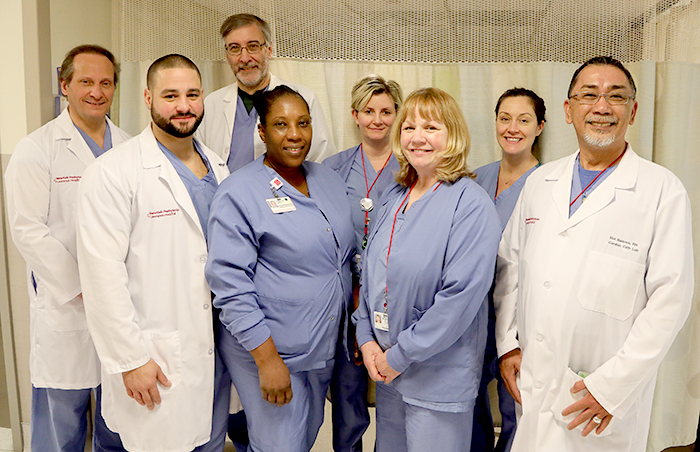Cardiac Catheterization Labs
If you think you are having a heart attack, do not wait — call 911 now. Do not attempt to drive yourself to the hospital.
When every minute counts, experience counts
At our two full-service Cardiac Catheterization Laboratories at NewYork-Presbyterian Westchester, ColumbiaDoctors perform emergency and elective angioplasty to unblock clogged heart arteries, in addition to other minimally invasive interventional procedures. Our 24/7 catheterization labs are among the few centers in Westchester County licensed to perform emergency cardiac angioplasty and treat acute myocardial infarctions (heart attacks).
An experienced cardiac catheterization team

In addition to interventional cardiologists, the Catheterization Labs are staffed by highly trained and specialized nurses, physician assistants, and angioplasty and electrophysiology specialists. Our team performs about 160 procedures every month, making us one of the most experienced catheterization programs in Westchester County
Speedy door-to-balloon time
The time between the arrival of a patient in the emergency room for treatment of a heart attack and insertion of a clot-busting balloon during angioplasty is called the door-to-balloon time. Nationally, it is advised that the door-to-balloon time not exceed 90 minutes, ensuring a patient’s best chance of survival. At NewYork-Presbyterian Westchester, our door-to-balloon time is less than 60 minutes — well below the national benchmark. This achievement is a direct reflection of the collaboration between our emergency and Cath Lab teams, leading to excellent quality measures and patient outcomes.
Award-winning expertise
We adhere to the American Heart Association’s “Mission: Lifeline” guidelines and use of the LIFENET® System, which emergency medical personnel use to wirelessly transmit a patient's data from the ambulance to our hospital. We can evaluate these data before the patient arrives and have everything in place when the ambulance pulls in, speeding the delivery of lifesaving cardiac care. Moreover, the Catheterization Labs are located upstairs from the emergency room, saving precious minutes for a patient who may be having a heart attack.
In recognition of our commitment to rapid cardiac care, NewYork-Presbyterian Westchester received the Mission: Lifeline STEMI Receiving Center Gold Award from the American Heart Association for the treatment of patients who suffer severe heart attacks. Our hospital was the only one in Westchester County to receive this distinction.
Cardiac catheterization procedures
We perform the following catheterization procedures at NewYork-Presbyterian Westchester:
Balloon angioplasty
During balloon angioplasty, a thin tube (catheter) is inserted into an artery in your groin or wrist. The doctor passes a tiny balloon through the catheter and guides it to the narrowed area in a heart’s blood vessel, where the balloon is expanded to stretch the artery open and restore blood flow.
Stent placement
Most people having balloon angioplasty have a small metal mesh tube called a stent inserted and expanded in the newly opened artery. The stent is left in place permanently as a scaffold to support the artery and maintain blood flow. We use the latest in stent technology, including drug-coated stents, whenever possible to reduce the risk of another blockage developing in the artery.
Arrhythmia diagnosis and treatment
Our cardiac electrophysiologists use catheterization techniques to diagnose the source of abnormal electrical impulses in the heart and offer ablation to treat arrhythmias such as tachycardia (rapid heart rate).
Pacemaker insertion
This device is implanted in your chest to ensure your heart beats at a normal rate. You may be referred for a pacemaker if you have had a low heart rate or fainting spells.
Implantable cardioverter defibrillator (ICD)
This device is implanted in the chest for continuous heart rhythm monitoring. If a life-threatening arrhythmia is detected, the device will deliver a shock to restore a normal heartbeat.
Biventricular pacemakers
We offer biventricular pacemakers and defibrillators to resynchronize the beating of the heart in people with congestive heart failure whose heart contractions have fallen out of sync ("cardiac resynchronization therapy" or CRT).
Implantable loop recorder
This device can be implanted in the chest to help analyze a patient's abnormal heart rhythms over several years and transmit the information back to the physician or other healthcare professionals. This device does not require wire implantation but analyzes the rhythm by measuring the heart's electrical signals from under the skin.
Right heart catheterization
A special catheter (small hollow tube) is inserted into the right side of your heart and measures the pressure inside your heart and lungs.
Direct current cardioversion (cardioversion/DCCV)
If you have a history of atrial fibrillation or atrial flutter (irregular heartbeat), this procedure is used to convert your heart to a normal rhythm using electrical impulses.
Atrial septal defect (ASD) or patent foramen ovale (PFO)
These are openings between the upper chambers of the heart that normally close soon after birth. If the ASD/PFO remains open, a small device is placed into the heart to repair the defect permanently. This is done through a minimally invasive catheter-based technique, which is typically performed within one hour.
Acute stroke endovascular therapy to remove a clot
A neurointerventionalist performs an endovascular procedure if the clot-busting drug tPA is not enough to treat an ischemic stroke and in patients for whom tPA is no longer an option. This minimally invasive procedure involves inserting a special device through a flexible tube guided to the blockage site to remove the clot and restore blood flow. Studies suggest that combining tPA with endovascular treatment may be more effective for some patients than using tPA alone.
Peripheral vascular disease treatment
We offer endovascular procedures to treat intermittent claudication and vascular insufficiency, using balloon angioplasty and stenting open blockages in the legs' arteries.
Endovascular aortic aneurysm repair
We also use catheterization to repair abdominal aortic aneurysms through a graft placement in the bulging area of the aorta.



